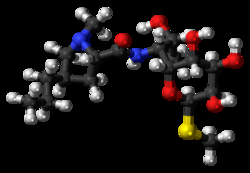January 15, 2015 report
Researchers unravel the elusive source of sulfur in an antibiotic

(Phys.org)—A team of researchers working at the Chinese Academy of Sciences in Shanghai has for the first time found the source of sulfur atoms in lincomycin A, a lincosamide widely used as an antibiotic agent. In their paper published in the journal Nature, the team describes their research efforts and results. Charles Melancon with the University of New Mexico outlines and comments on the work done by the team in the same journal issue.
As Melancon notes, there are a host of molecules vital for biological processes that have sulfur as a component—their metabolic origins can be predicted as a matter of course. Sulfur atoms on the other hand have been much more difficult to predict. Overcoming such obstacles for some molecules could have benefits such as helping to develop new medicines. In this new effort the researchers set their sights on lincomycin A, an antibacterial agent that has been used to treat Gram-positive bacterial infections for many years.
To find the sulfur source, the researchers used modern whole genome sequencing techniques to work backwards through likely pathways looking to isolate intermediaries that tended to build up as genes were disrupted. Doing so led to the discovery that disruption of lmbE led to intermediates that looked a lot like lincomycin—that led them to study lambV, a gene that also shows up in lincomycin, which led to the discovery of another intermediary. The team also tested other enzymes and found a way to prove that there were at least three of them that incorporated sulfur into parts of the antibiotic, which was the original goal, of course. More specifically, they found that two bacterial thiols played a constructive role in the biosynthesis of lincomycin A. The team then went further, isolating the materials that were produced due to the genes involved, along with the functions of enzymes that were part of the process.
Work done by the team should help provide a pathway for other researchers attempting to find the source of sulfur atoms in other molecules, perhaps leading to new types of materials for use in a variety of medical purposes, from antibiotics to cancer fighting agents.
More information: Metabolic coupling of two small-molecule thiols programs the biosynthesis of lincomycin A, Nature (2015) DOI: 10.1038/nature14137
Abstract
Low-molecular-mass thiols in organisms are well known for their redox-relevant role in protection against various endogenous and exogenous stresses1, 2, 3. In eukaryotes and Gram-negative bacteria, the primary thiol is glutathione (GSH), a cysteinyl-containing tripeptide. In contrast, mycothiol (MSH), a cysteinyl pseudo-disaccharide, is dominant in Gram-positive actinobacteria, including antibiotic-producing actinomycetes and pathogenic mycobacteria. MSH is equivalent to GSH, either as a cofactor or as a substrate, in numerous biochemical processes4, most of which have not been characterized, largely due to the dearth of information concerning MSH-dependent proteins. Actinomycetes are able to produce another thiol, ergothioneine (EGT), a histidine betaine derivative that is widely assimilated by plants and animals for variable physiological activities5. The involvement of EGT in enzymatic reactions, however, lacks any precedent. Here we report that the unprecedented coupling of two bacterial thiols, MSH and EGT, has a constructive role in the biosynthesis of lincomycin A, a sulfur-containing lincosamide (C8 sugar) antibiotic that has been widely used for half a century to treat Gram-positive bacterial infections6, 7, 8, 9. EGT acts as a carrier to template the molecular assembly, and MSH is the sulfur donor for lincomycin maturation after thiol exchange. These thiols function through two unusual S-glycosylations that program lincosamide transfer, activation and modification, providing the first paradigm for EGT-associated biochemical processes and for the poorly understood MSH-dependent biotransformations, a newly described model that is potentially common in the incorporation of sulfur, an element essential for life and ubiquitous in living systems.
Journal information: Nature
© 2015 Phys.org


















